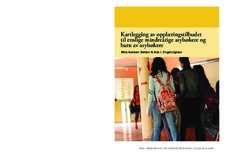Kartlegging av opplæringstilbudet til enslige mindreårige asylsøkere og barn av asylsøkere
Report

Åpne
Permanent lenke
https://hdl.handle.net/20.500.12199/3353Utgivelsesdato
2011Metadata
Vis full innførselSamlinger
- NIBR notat [1018]
Sammendrag
This report is about the educational opportunities for minor, unaccompanied asylum-seekers and children of asylum-seekers in Norway. The report is based on surveys to municipalities and counties and on interviews with employees at asylum-seeker centres and care-centres for minor unaccompanied asylum-seekers. The main aim was to investigate whether asylum-seeking children between the age of six and 18 are given educational rights and opportunities according to laws and regulations and whether their educational oppor¬tunities are equal to those of children in Norway in general. The study shows that most communes that have these students in their schools arrange the education either in introductory classes for Norwegian learners, in ordinary classes, or in both. The main findings from the study are that children of asylum-seekers and unaccompanied minor asylum-seekers, in accordance with laws and regulations, have the same opportunities regarding primary and lower secondary education as other children. There are two main exceptions: 1) Very few of these students are offered dual-language education and an even smaller number are offered mother-tongue education which is their right and which is officially recommended. 2) Most of these students are given supplementary education in Norwegian at the expense of several other subjects taught to students in general. Upper secondary education is not a right given to children of asylum-seekers (it is for minor unaccompanied asylum-seekers), but Norwegian counties may give asylum-seekers opportunity to enter upper secondary school if they have passed the equivalent of Norwegian primary education. The study shows that most counties allow entrance into upper secondary education for young asylum-seekers. Hva slags opplæringstilbud får asylsøkerbarn i norske kommuner, og hvilke erfaringer har ansatte på omsorgssentre og statlige mottak med samarbeid om barnas skolegang? Denne kartleggingen, som er utført for Utdanningsdirektoratet, tyder på at de aller fleste asylsøkerbarn i grunnskolealder får grunnskoleopplæring kort tid etter ankomst til mottak og omsorgssentre. I de aller fleste kommuner kan asylsøkere med nødvendig kompetanse få plass i videregående opplæring etter søknad. Det er stor variasjon mellom kommuner når det gjelder organisering av opplæringen, men de fleste kommuner gir opplæring både i innføringsklasser og ordinære klasser. Det er imidlertid store mangler når det gjelder tospråklig fagopplæring og morsmålsundervisning. Kartleggingen tyder på at det er forholdsvis få ansatte i grunnskoleopplæringen som har formell kompetanse rettet mot tospråklig fagopplæring.